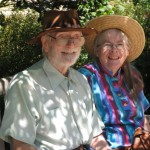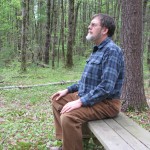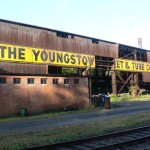“Nature is not mute. It is man who is deaf.” – Terence Mckenna
If we accept that land is alive, and has spirit and the ability to communicate to us how (and whether) it wants to relate to us, how do we find out what that is?
I’ve said that I respect Andras’s family’s patience in learning to hear from their land before diving in to constructing sacred sites on it, and it’s something that I think Peter and I share. But what is it that we’re “hearing,” and how are we best to listen for it?
This is where Andras’s ideas and mine diverge–in theory, if not in practice.
I’m tempted to go into detail here, explaining some examples of what happens when Pagans don’t listen to the land, but instead arbitrarily impose their preconceived notions about what kinds of shrines they “get” to construct on land once they own it.
Unfortunately, if I give specific examples, those who have been to those sites or were the ones to build them will probably recognize the examples enough to be insulted–but probably not enough to change how they relate to the land. So many of us are partially or completely tone-deaf when it comes to spiritual listening, and it’s hard to know what to do about that. I’m sure this is part of the reason so many people who do past life work turn out to have been Cleopatra in a past life, and why so many more people have eagles and wolves for spirit guides than have turkey buzzards, chipmunks, or mice.
We are all Very Important People… to ourselves. And it can be hard for any spiritual voice to get through the sound of our own subjectivism. (This is as true among Quakers as among Pagans, of course, though the results of mistaking our own wishes for God’s voice are less colorful and less useful as comic relief.)
Andras spoke about this briefly at his talk. “People come to me, and they say, ‘Rocks speak to me!’ And I say, ‘That’s very nice. What language are they speaking in? English? How amazing–a rock that is tens of thousands of years old, and it speaks perfect English!'”
I take his point… as well as taking in the reason he was raising it: it is hard to learn how to listen to what the land itself may have to say when we come to the land with so many expectations we can nimbly project onto every object we see.
Andras’s suggestion for cutting through the fog of our self-deception, though, is different from mine.
At Glenshire Farm, where the Arthens live, there are plenty of human structures: homes, outbuildings, and so on. There are gardens. There is open land, and there is forest. There are sacred sites where humans interact with whatever spiritual presence connects with us through those gateways… and there is “wilderness.”
The scare quotes above are not to mock Andras’s use of the term wilderness for the wooded portions of his land, but to mark a particular interpretation and meaning of that word. For while it would be hopelessly naive to believe that any woods in New England (or possibly, any landscape anywhere in the world) is wilderness in the sense of being untouched by human beings, the way Andras uses the word is meaningful. What he means by wilderness are places where the land is left “to itself,” to be shaped by whatever its own resources (spiritual or biological) might be, rather than to be shaped by humans.
 |
| Rob Larsen, 2004. Stone Wall. |
While the forests of New England have been shaped by human activity for thousands of years, so that there is a sense in which no land here is purely wilderness, that’s not to say that it’s meaningless to allow the land to grow and change, spiritually as well as ecologically, to its own forms. I agree that this is a spiritual good.
However, Andras goes further. It is in wilderness, he says, that we learn to hear the spirits of the land. And whether human intrusions happened a year ago or thirty years ago, the more seemingly secluded land is from the sights or sounds of human activity, the more like wilderness it becomes, as a spiritual matter–and the more effective that land is, as a teacher.
I disagree for a number of reasons.
First of all, this definition of wilderness becomes human-centered as soon as we take apparent isolation from humans to be a mark of its presence. For while the sounds of traffic and airplanes overhead may be disruptive to my meditations out in the woods, other things, from acid rain to invasive species, may be far more disruptive to the spirits and species of a particular area. It’s not how wild a place seems to me that matters, surely, but how whole and healthy its ecosystem is, and how well-suited to that landscape.
So I’m a little suspicious, to begin with, of a prescription to shake human projections loose from our interactions with wild places that begins by putting human experience at the center of what we mean by wild.
More importantly, I disagree with this approach experientially. It just doesn’t jive with my own encounters with the spirits of land and place.
Maybe this is as good a place as any to confess that, while I don’t hear rocks talking to me… I have heard trees.
So to speak. And no, they don’t use words, that I’ve ever heard–not in English or any other language. And I was as surprised as anyone, when it began to happen to me.
It started like this.
I was living in a tiny apartment downtown in a small Vermont village, only a few short blocks from the my daughter’s daycare. We walked almost everywhere–one of the advantages of village life. But for all that, and all the sometimes-quaintness of a small town in Vermont, you must not picture my living in a Thomas Kincaid print. My walk took me past junked cars as well as rose bushes. There were mountains in the distance, but I crossed railroad tracks, bypassed rusted oil drums, and walked on well-worn asphalt sidewalks much of my way through. It was not bucolic, and by no stretch of the imagination was it anyone’s definition of wilderness.
I had just dropped my daughter off for the morning, and was on my way back to begin work. It was a warm day in early summer, with birds singing, a few lazy cyclists riding by, but mostly just the satisfaction that comes from walking quietly under a sunny sky. I was on a side street, well away from the main road, when I walked under a spreading maple tree with a thick trunk that had buckled the sidewalk underfoot.
And just as I walked past I felt… something. Something soft.
It was much more like the touch of a friendly cat, twining between the legs of a human it likes, than it was like language. It was not literally a touch–I felt it inwardly and not on my skin.
But it startled me. I had not been looking for anything unusual that morning. I was not thinking about the tree; I was not even thinking particularly spiritual thoughts. But still… there it was.
Like a hand on my shoulder: something alive seemed to be saying hello. So I stood still for a moment or two, my arms spread a bit away from my body. And I tried, as best I could, to say hello back.
I don’t know how successful I was, but I do know that, from that point on, I took that route whenever I could, and made a point of “listening” for my tree. And sometimes, it seemed to greet me. And sometimes, it did not.
Likewise, in the years since, I’ve tried to “listen” for other trees. Some seem to greet me, to recognize me, and some do not. Some seem inert. Some seem closed for business, and uninterested in mankind–or at least in me. Some seem downright hostile. (Come to think of it, that’s a lot like cats, isn’t it?)
But every now and then, there will be a “friendly” seeming one, and I will pause for a while, and… try, at least, to return the communication.
I’ve never succeeded in communicating with a very young tree. Larger trees seem “louder” to me, perhaps? I haven’t entirely worked it out. I have, however, connected with trees of any number of species, and in all sorts of locations, from sidewalks to parks, old woodlots to college campuses.
I wouldn’t say that the tree’s location makes no difference–I have the feeling that the row of magnificent old oaks by Northampton’s Forbes Library, standing beside a bustling main artery, have no patience with our species at all. But “wilderness” does not seem to be part of the equation that allows me to have that fleeting sense of connection with a tree.
What’s more, wilderness–in the sense Andras means it, or any other–does not seem to be part of the equation that allows me to have a different, subtler sense of connection with the spirits of particular places. Quite the opposite, in fact.
I grew up in the woods, far from the sound of cars and humans. What’s more, as a young woman, I loved climbing mountains. I have spent time where land is truly wild, where roads are miles distant and never plowed, in landscapes of rock, dwarfed pine, and lichen. The tops of tall mountains are like desert islands, awash in an ocean of air.
And some of what I think Andras was trying to convey is true. Projecting human wishes and ideals onto such a landscape is transparently folly when you are up there. It is wonderful to discover that for yourself, in your body and not just in thought. I remember my youthful joy (and the small shiver of fear) as I picked my way along the Knife Edge Trail on Mt. Katahdin for the first time. There’s a steep drop-off on both sides, and in places, the trail is narrower than seems safe. What’s more, the trail is over loose, wobbly boulders. While crossing them, they shift under your weight as you cross.
It turns out, when they made mountains, they left out the handrails. There are places where you can feel the lack.
 |
| Greg Neault, 2008. Baxter Peak and the Knife Edge Trail. |
Now, the Knife Edge is not actually very dangerous; the trail is traveled by hardy children and elders, and no special mountaineering skills are needed to use it. But my joy and my fear weren’t about the danger of it–my emotions were rooted in the pure, bare alienness of that landscape. It wasn’t a fear of falling that made me catch my breath.
It was how clear it was that there was nothing in the mountain that cared one way or another if I did.
The mountain did not hate me. It was not hostile. It simply found me as unimportant as did the birds and clouds overhead.
Wilderness may be a good place to lose a sense of being the center of the universe. But wilderness, generally speaking, has nothing to say to man. We are irrelevant to it.
To the extent that I have encountered wilderness in this world, I have found it to be completely indifferent to me. I love it, I value it, I long to preserve it and protect it. But never on any day have I felt that it had any interest in “speaking” to me in any personal sense at all.
Wilderness, then, is the last place I would send someone who was trying to learn to connect to the spirits of the land.















